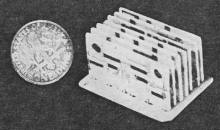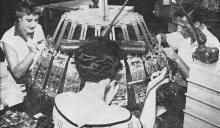|
March 1960 Electronics World
 Table of Contents
Table of Contents
Wax nostalgic about and learn from the history of early electronics. See articles
from
Electronics World, published May 1959
- December 1971. All copyrights hereby acknowledged.
|
As one born in 1958, it's hard
to accept that 1960 news is nearly six decades old. I still find myself thinking of the
1970s and 80s as just a few years ago. The first
integrated semiconductor circuits were still being developed in corporate
and university laboratories in 1960. Fairchild announced a year after this Electronics
World article appeared their first commercial IC series, named "Micrologic." Until then, an integrated circuit meant something like
the compact module of interconnected ceramic substrates with printed thick film resistors
and miniature discrete components. In other news, Raytheon was ready to deploy their
giant ICBM tracking radar system to deal with the emerging global nuclear war threat,
while the Martin Company (now Lockheed-Martin) was building guidance systems for our
own missiles, and General Electric was building testers for missile guidance systems.
Hall effect transducers and super-sensitive TV cameras got honorable mention as well.
Recent Developments in Electronics
 Microminiature Circuits Microminiature Circuits
The first model of a complete adder circuit for use in a ballistic missile computer
is shown full size in the photo. The unit, made up of 7 ceramic-plate circuits, has been
reduced by fifty times in volume over the smallest package that has been made with conventional
parts. Some 85 components (resistors, capacitors, and transistors) are in the 1/2" x
1/2" X 1" package. All components except the transistors are presently available in commercial
quantities from Aerovox Corp., and the transistors will soon be available. Ceramic base
plate circuits may be interconnected as shown or contacts at one or more of the edges
may be used with special connectors. The whole unit can be hermetically sealed if required.
 Five-Story Tracking Radar Five-Story Tracking Radar
This huge unique radar, designed to track ICBM's at a distance of thousands of miles,
will be developed for the Advanced Research Projects Agency by the Raytheon Co. The five-story
high antenna, which fires a narrow pincushion-shaped microwave beam from the radar transmitter,
weighs 80 tons. The new radar will be one of the nation's longest range precision units.
Scheduled for late-1961 delivery, the radar is to be used in conjunction with missile
test firings in the Pacific.
 Tester for Guidance-System Tubes Tester for Guidance-System Tubes
Electron tubes which have key functions in the guidance systems of missiles such as
the "Jupiter" and "Atlas" undergo a rigid testing program at General Electric's power
tube plant at Schenectady, New York. Test operator is shown checking microwave triode
tubes that are undergoing a 500-hour pulsed life test under actual operating conditions.
Tubes are checked every 48 hours for power output. The complete testing procedure lasts
for some 500 hours.
 Super-Sensitive TV Camera Tube Super-Sensitive TV Camera Tube
A new super-sensitive TV camera tube, type GL-7629, has been released by G-E. The
new image orthicon is physically and electrically interchangeable with a standard camera
tube, but it requires from 1/10 to 1/20 the light needed by standard tubes now in use.
It can produce usable pictures at one footcandle of illumination. Photo shows the same
scene televised with a standard orthicon (left) and with the new tube (right). Tube shows
great promise in color work.
 Missile Circuit Assembly Aid Missile Circuit Assembly Aid
This new rotary wheel has replaced the standard assembly line workbench in assembling
small missile electrical and electronic components at The Martin Co. The wheel has 24
assembly positions and automatically rotates clockwise at a predetermined rate as three
operators, working as a team, assemble components (in this case demodulators). A power-operated
rotary switch permits remote control of special electrical circuits for stepping, counting,
and selecting.
 Hall-Effect Power Transducer Hall-Effect Power Transducer
Hall Effect refers to the generation of small voltage due to the displacement of positive
or negative charges within a material in a magnetic field. Employing this principle,
Westinghouse's new Hall multiplier is employed as a power transducer, being used to convert
a.c. watts to a d.c. millivolt control signal. This signal may be applied to a control
device or to a telemetering transmitter. The new transducer has a much higher speed of
response than the thermal converters usually employed.
Posted June 13, 2018
|

































